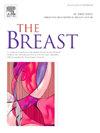The association between breast fibrosis, cosmetic outcomes, and long-term health-related quality of life after breast-conserving therapy: a multicenter cross-sectional observational cohort study
IF 7.9
2区 医学
Q1 OBSTETRICS & GYNECOLOGY
引用次数: 0
Abstract
Background
Breast fibrosis is a well-known late side-effect of breast-conserving therapy (BCT) and may lead to breast retraction, asymmetry, and pain. Since life expectancy of breast cancer patients has significantly improved in the past decades, cosmetic outcomes and health-related quality of life (HRQoL) have gained importance. This study aimed to investigate the association between breast fibrosis, cosmetic outcomes, and various HRQoL domains.
Methods
In this multicenter, cross-sectional, observational cohort (STARLINGS study), breast fibrosis was assessed (CTCAE version 5), breast photos were analyzed with BCCT.core software, and participants completed BREAST-Q, EORTC QLQ-BR23/C30, and 9-item cosmetic questionnaire. Associations between breast fibrosis and HRQoL and between cosmetic outcomes and HRQoL, were analyzed using multivariable linear regression, both unadjusted and adjusted for age, smoking and body mass index.
Results
A total of 775 patients treated between 2016 and 2020 were included, with median follow-up of 4 years. Compared to patients with moderate/severe breast fibrosis, patients with none/mild breast fibrosis reported better HRQoL on all domains, except Sexual Functioning, Sexual Enjoyment, and Physical and Social Functioning. Patients with excellent/good cosmetic outcomes reported better HRQoL than patients with fair/poor cosmetic outcomes on five out of 18 HRQoL domains, but not on any of the Symptoms domains.
Conclusion
Our results indicate that breast fibrosis and unfavorable cosmetic outcomes are negatively associated with various HRQoL domains. Additionally, breast fibrosis is associated with locoregional symptoms and fatigue, whereas unfavorable cosmetic outcomes are not. This large multicenter study corroborates the interrelated nature of breast fibrosis, cosmetic outcomes, and HRQoL (ID: NCT05263362).
保乳治疗后乳腺纤维化、美容结果和长期健康相关生活质量之间的关系:一项多中心横断面观察队列研究
背景:乳房纤维化是保乳治疗(BCT)的一个众所周知的晚期副作用,可能导致乳房内缩、不对称和疼痛。由于乳腺癌患者的预期寿命在过去几十年中有了显著改善,因此美容结果和与健康相关的生活质量(HRQoL)变得越来越重要。本研究旨在探讨乳腺纤维化、美容结果和各种HRQoL域之间的关系。方法在这个多中心、横断面、观察队列(STARLINGS研究)中,评估乳房纤维化(CTCAE版本5),用BCCT分析乳房照片。核心软件,并完成BREAST-Q、EORTC QLQ-BR23/C30和9项化妆品问卷。使用多变量线性回归分析乳腺纤维化与HRQoL之间的关系,以及美容结果与HRQoL之间的关系,包括未调整和调整年龄、吸烟和体重指数。结果2016 - 2020年共纳入775例患者,中位随访时间为4年。与中度/重度乳腺纤维化患者相比,无/轻度乳腺纤维化患者的HRQoL在所有领域都更好,但性功能、性享受、身体和社会功能除外。在18个HRQoL领域中的5个领域中,美容结果优秀/良好的患者报告的HRQoL优于美容结果一般/差的患者,但在任何症状领域均无此表现。结论乳腺纤维化和不良美容结果与各HRQoL域呈负相关。此外,乳房纤维化与局部症状和疲劳有关,而不良的美容结果则与之无关。这项大型多中心研究证实了乳腺纤维化、美容结果和HRQoL之间的相关性。
本文章由计算机程序翻译,如有差异,请以英文原文为准。
求助全文
约1分钟内获得全文
求助全文
来源期刊

Breast
医学-妇产科学
CiteScore
8.70
自引率
2.60%
发文量
165
审稿时长
59 days
期刊介绍:
The Breast is an international, multidisciplinary journal for researchers and clinicians, which focuses on translational and clinical research for the advancement of breast cancer prevention, diagnosis and treatment of all stages.
 求助内容:
求助内容: 应助结果提醒方式:
应助结果提醒方式:


